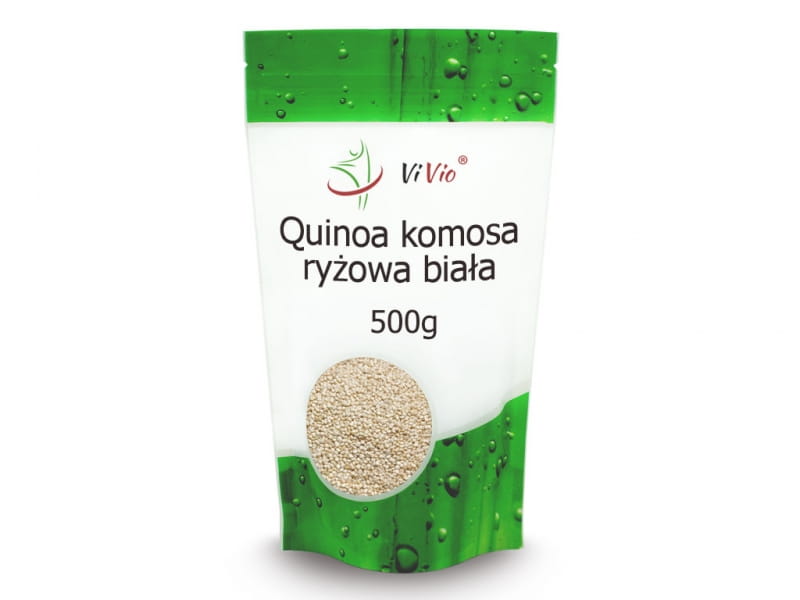White Quinoa Quinoa 500g VIVIO
- Regular price
- €5,10
- Regular price
-
- Sale price
- €5,10
- Unit price
- per
Couldn't load pickup availability
Description
xQuinoa - how does it taste?
Quinoa has a characteristic, sweet taste and is therefore suitable for the preparation of main dishes and desserts.
White quinoa is widely used in everyday human cooking. When cooked soft, it is ideal as an accompaniment to meat or fish dishes. Thanks to its swelling properties, it can also be a great thickener for vegetable-heavy sauces and soups. It is also important to know that this product is perfect for making healthy desserts. On its basis we can prepare both nutritious custard and crunchy cookies. Quinoa (lightly cooked) is also a great ingredient for delicious salads.
How do I cook quinoa? Span >
Dry quinoa grains should be rinsed well under running water. Then cook for about 10-15 minutes. Quinoa is cooked in a ratio of 1:2 (1 glass of quinoa, 2 glasses of water).
Ingredients: White Quinoa

" Reference intake for an average adult
(8,400kJ / 2,000kcal)".
The product may contain: soy, gluten, mustard, nuts and sesame seeds.
em>
Komosa has a unique amino acid composition. No other plant contains such a useful set of essential amino acids. The protein content is between 12 and 22%. It is an easily digestible protein and interestingly, the heat treatment, i.e. cooking, further increases its digestibility. Therefore, quinoa is an ideal source of valuable protein in the diet of vegetarians, children, pregnant women and seniors.
It is worth paying additional attention to the content of unsaturated fatty acids (linoleic and oleic acid). "Protected" from oxidation with a large amount of antioxidant vitamins, mainly A and E. In addition, quinoa is a good source of B vitamins, folic acid, minerals: magnesium, potassium and calcium, as well as phytosterols, saponins and phenols.
Comosa differs from other pseudocereals in the content of flavonoids in its composition. Quinoa contains 58 mg/100 g, twice as much as in cranberries. This is a valuable and unique trait as grains generally do not contain flavonoids.
Quinoa also contains fiber, including inulin. As a result, it has a strong prebiotic effect and can be recommended as a dietary measure for people with poor microflora in the digestive system. In turn, thanks to the content of saponins, it can show antiallergic, anti-inflammatory, antifungal, antiviral and immunostimulating effects.
similar products
- Regular price
- €5,10
- Regular price
-
- Sale price
- €5,10
- Unit price
- per
- Regular price
- €5,10
- Regular price
-
- Sale price
- €5,10
- Unit price
- per
- Regular price
- €5,10
- Regular price
-
- Sale price
- €5,10
- Unit price
- per
- Regular price
- €5,10
- Regular price
-
- Sale price
- €5,10
- Unit price
- per
- Regular price
- €5,10
- Regular price
-
- Sale price
- €5,10
- Unit price
- per
- Regular price
- €5,10
- Regular price
-
- Sale price
- €5,10
- Unit price
- per
- Regular price
- €5,10
- Regular price
-
- Sale price
- €5,10
- Unit price
- per
- Regular price
- €5,10
- Regular price
-
- Sale price
- €5,10
- Unit price
- per
- Regular price
- €5,10
- Regular price
-
- Sale price
- €5,10
- Unit price
- per
- Regular price
- €5,10
- Regular price
-
- Sale price
- €5,10
- Unit price
- per
Recently Viewed Products
- Regular price
- €5,10
- Regular price
-
- Sale price
- €5,10
- Unit price
- per
- Regular price
- €5,10
- Regular price
-
- Sale price
- €5,10
- Unit price
- per
- Regular price
- €5,10
- Regular price
-
- Sale price
- €5,10
- Unit price
- per
- Regular price
- €5,10
- Regular price
-
- Sale price
- €5,10
- Unit price
- per
- Regular price
- €5,10
- Regular price
-
- Sale price
- €5,10
- Unit price
- per
- Regular price
- €5,10
- Regular price
-
- Sale price
- €5,10
- Unit price
- per
- Regular price
- €5,10
- Regular price
-
- Sale price
- €5,10
- Unit price
- per
- Regular price
- €5,10
- Regular price
-
- Sale price
- €5,10
- Unit price
- per
- Regular price
- €5,10
- Regular price
-
- Sale price
- €5,10
- Unit price
- per
- Regular price
- €5,10
- Regular price
-
- Sale price
- €5,10
- Unit price
- per
- Choosing a selection results in a full page refresh.











